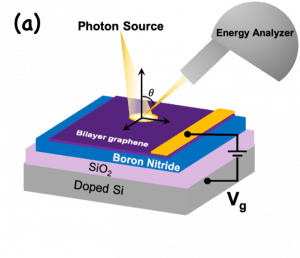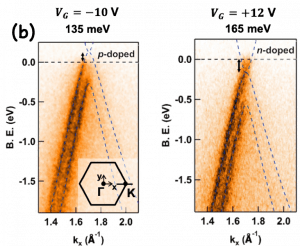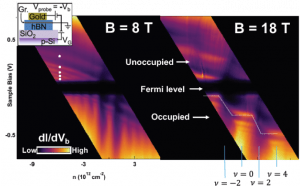Throughout the history of human civilization mastery of materials has been a catalyst for significant societal advancements. For example, mastery with metallurgy was a major contributing factor for the industrial revolution, mastery with the passivation and control of Si enabled Si-based FETs, which are the fundamental component of the electronic devices that are so prevalent in our everyday lives. This is often referred to as the first quantum revolution, or the digital revolution.
Currently, we are in the midst of a new revolution that is fueled by quantum materials, examples include graphene, transition metal dichalcogenides (TMDs), topological insulators among many others. The manipulation and harnessing of quantum states hosted in these materials has the potential to revolutionize computation, sensing, storage, and communications, thus affecting multiple facets of our society. Additionally, from a fundamental standpoint, the harnessing and manipulation of quantum states could be used to develop novel simulators that allow the exploration of new physics and/or potential for solving difficult intractable problems.
The Velasco lab is an experimental materials/condensed matter group that specialize in the fabrication and characterization of novel 2D material devices with unprecedented sensitivity and atomic scale precision. Our aim is to attain a deep and fundamental understanding of the electronic properties of 2D material-based quantum devices. In addition to advancing fundamental knowledge, our efforts yield insights that can be utilized for the development of novel quantum sensors, simulators, and qubit platforms.
Below our major research thrusts are outlined. Currently, our main characterization scheme is scanning tunneling microscopy/spectroscopy (STM/STS) and related scanned probe techniques.
1. On-demand characterization of quantum defects in two-dimensional materials
In this thrust we use advanced scanned probe microscopies and first principles calculations to visualize, measure, and model one defect at a time. This will address the lack of fundamental understanding of individual point defects in 2D materials at the atomic scale. Such defects are a promising platform for the next generation information processing technology and have the potential to revolutionize present day computing, information storage, and sensing paradigms. The first principles component for this thrust is lead by Professor Yuan Ping’s group. We also collaborate with Professor Aiming Yan’s group for studies that involve pristine and doped TMD samples, which are synthesized in her lab.

Figure 1: STM/STS study of point defects on the surface of multilayer graphene devices. (a) and (b) are the same surface imaged at different gate voltages revealing the scattering caused by point defects on the surface of a multilayer graphene device.
Related publications: (1) Nano Letters 2021; (2) Physical Review Letters 2021
2. Harnessing Quantum Chaos in 2D material devices
In this thrust we advance fundamental understanding of chaotic quantum phenomena in 2D material heterostructures. This knowledge will enable the development of new schemes for controlled nanoelectronics with low power operation. Our approach consists of a tightknit collaboration involving scanning probe microscopy-based experiments and highly tailored theoretical modeling provided by Professor Eric Heller’s group. We will focus on two types of quantum-chaotic phenomena known as quantum scarring and superwire channeling. Quantum scarring originates from constructive quantum interference and can favor certain unstable pathways in an otherwise chaotic system. Superwire channeling consists of dynamic “wires” that gently guide electrons in patterned channels on the several nanometer scale. The harnessing of these chaotic phenomena will enable novel methods for selective and flexible delivery of electrons at the nanoscale.

Figure 2: Direct visualization of relativistic quantum scars in graphene quantum dots. (a) STS map of a lemniscate shaped quantum scar. (b) Wave packet based simulation revealing the same quantum scar from (a).
Related publications: (1) Nano Letters 2021; (2) Nature 2024
3. Quantum devices for simulators and sensors
Whereas conventional quantum devices utilize spin and/or charge as a quantum degree of freedom for information processing this thrust will focus on orbital magnetic magnetism in quantum devices such as quantum dots (QDs) based on 2D materials. The orbital magnetism in these devices hosts remarkable properties such as giant magnetic moments with electric field tunability. These properties can be leveraged for new, robust, and flexible modalities of quantum sensing, information processing, and simulation.

Figure 3: Giant orbital magnetic moments in graphene based QD devices. (a) Giant orbital magnetic moments measured in monolayer graphene QD devices, emerging from the exotic relativistic physics hosted in graphene. (b) Giant orbital magnetic moments measured in trailer graphene based QD devices, emerging from the finite Berry curvature hosted in gapped graphene systems.
Related publications: (1) Nano Letters 2020; (2) Physical Review Letters 2021; (3) Nature Nanotechnology 2023
4. Nanospot Angle Resolved Photoemission Spectroscopy (ARPES)
In this thrust we use an ARPES microscope with sub micron resolution to directly visualize and spatially map the electronic band structure of 2D quantum material devices. This enables visualization of topological transitions and many-body spectral reconstructions that are induced and manipulated by electric fields. Such visualization could validate untested theories regarding many-body interactions and new topological properties and transform our understanding of electronic devices based on 2D materials.


Figure 4: NanoARPES of 2D quantum material devices. (a) A photon source shines on the BLG/hBN heterostructure device surface and reflected light is collected by an energy analyzer. This scheme can directly probe the BLG band structure, band structure modifications due interactions between BLG and hBN, and band structures at different Fermi levels. (b) ARPES E-k spectra obtained at gate voltages of -10 V (p-doped) and +12V (n-doped). Left axis is the binding energy (B. E.); bottom axis is the in-plane momentum. The Fermi level (B. E.=0 eV) is denoted by a dashed black line in each spectrum. The tight-binding bands are superimposed on each spectrum. Inset of left panel in (b) indicates the direction of the measurement.
Related publications: (1) Nano Letters 2019; (2) Physical Review B (Rapid) 2019
5. Tunneling Spectroscopy via planar tunnel junctions
In this thrust we use a planar tunnel junction composed of 2D materials to measure the single particle density of states (SPDOS) of 2D quantum materials at ultra low temperatures(~250mK) and exceptionally high magnetic fields (18T). The SPDOS is directly calculable and encodes the nature of electron-electron interactions, which are abundant in extreme experimental conditions such as millikelvin temperatures and ultra-high magnetic fields.

Figure 5: Planar tunneling spectroscopy in ultra high magnetic fields and low temperatures. Tunneling spectroscopy maps of graphene at B = 8 T and B = 18 T. At 18T several Landau levels(LLs) are visible including LLs due to broken symmetry states such as ν=0 and ν=4.
Related publication: Applied Physics Letters 2019
Interested prospective PhD students should apply to the physics department at UCSC. Funding opportunities exist in the form of research and teaching assistantships.
For more information please contact Professor Velasco at jvelasc5@ucsc.edu.